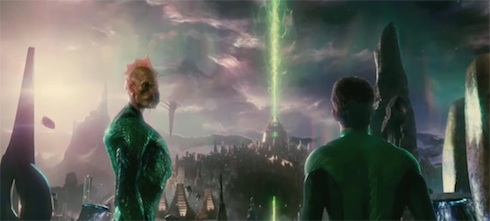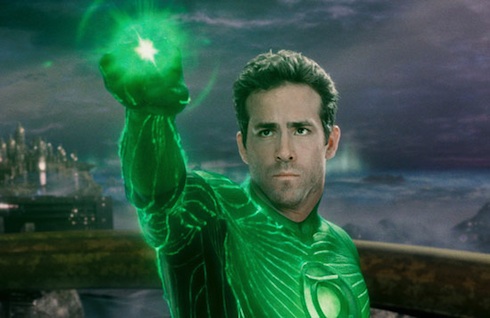Several times throughout Green Lantern, Carol Ferris (Blake Lively) accuses Hal Jordan (Ryan Reynolds) of being immature and/or acting like a child. This assessment is a fairly accurate description of the film’s overall tone; the dialogue is uninspired, the scenes could seemingly occur in any order, and several of the characters seem unnecessary. Too bad, since the concept of the Green Lantern ring allows for one’s imagination to create all sorts of amazing things in the physical world. But because Hal Jordan and his screenwriters had such dull ideas, Green Lantern wasn’t the feel-good silly romp it could have been. Instead, it was just a little boring.
The film essentially presents two different narratives; one on Earth and one out in space. These two stories are linked through the notion of an evil being called Parallax returning to envelop the universe in fear. Out in space, the Green Lantern Corps are having a rough time containing Parallax and have started to worry that their devotion to the notion of “will” might not be enough in the face of a being composed exclusively of “fear.” The bosses of the Green Lantern Crops; The Guardians, are pretty worried, too, and have decided that maybe it’s time to create a power ring constructed out of the yellow energy of fear, rather than the green energy of will. All of this color-coding is a little silly in the comic book source material of Green Lantern, but rendered all the more ridiculous in a big screen movie. However, if the film had focused more on all the goofy looking aliens struggling to decide which emotional power source they were going to put their faith in, it might have been a better flick. Instead, the movie has to tell the story of the human Green Lantern, Hal Jordan, which is where things really run into trouble.
Nearly all the scenes on Earth with Hal seem like they could take place in any order and the editing of said scenes was sort of arbitrary. Except for important “plot” moments (like when he first gets the ring) most of these scenes are conversations between Hal and Carol in which they discuss whether he is or is not brave enough to actually get something done. Sometimes they’re talking about him being an airplane pilot, other times they’re referring to him being good at being a Green Lantern. And though Blake Lively is actually one of the stronger actors in the movie, in nearly all cases, the dialogue goes something likes this:
Hal: I don’t know, maybe I’m just a fuck-up.
Carol: No, you’re not. I mean you kind of are, but that’s why I like you. But I bet you can be a brave fuck-up.
Hal: Maybe. I think I’ll try.
Carol: You are brave.
Hal: I know.
Carol: But not very smart.
Hal: Too bad for you.
Carol: Yeah, oh well.
Hal: Let’s talk about this again later in the exact same way. I’ve got to go away for some reason.
Carol: Bye.
And this basically passes for character development and romance. Sometimes this dialogue scene is inverted with Carol saying Hal is a loser with him convincing her the opposite. In all cases, other than some flashbacks about Hal’s childhood, we don’t really get to know him; we’re just sort of told to like him. Ryan Reynolds doesn’t do an awful job here, and I certainly found myself wanting to like him throughout. It was just that I kept waiting for all these conversations between Hal and Carol to really pay off and for Hal to step it up and do something truly brave and creative.
The essential premise of the Green Lantern power ring is a promising one. People can combine their will power with their imagination to create constructs that help them solve problems. This seems to be a pretty hopeful metaphor for how we all get through our lives on a daily basis. In fact the notion that fear can destroy all of our imaginative constructs is pretty terrifying and I think speaks to the sort of self-esteem issues most people face.
In Green Lantern however these issues are handled so a child can understand them. And instead of Hal Jordan doing something truly imaginative with his will power in order to defeat Parallax, he does something very predictable. After all, everyone understands what a big giant green fist looks like.
Compounding the already troubled narrative is the evil human scientist character Hector Hammond (Peter Sarsgaard). This conceit I found particularly dull. From the first scene this character is made to be unlikable, from his slovenly appearance and on down to the fact that he is eating gross food. Through a botched alien autopsy, Hector becomes linked/infected by Parallax, which for some reason gives him telepathic and telekinetic abilities. Why this occurs is never explained, and his motivations for being a jerk and being the tool of Parallax aren’t really explored either. In the end, Hector is absorbed by Parallax, rendering his importance to the plot totally moot.

There were a few things to like about Green Lantern however, and as I said, if viewed as a kid’s movie, it’s not terrible. It’s a nice touch that nobody is fooled by Hal’s mask at all and that Carol knows it’s him almost right away. Also, I was absolutely delighted by all the aliens from the Green Lantern Corps, particularly the fish/bird alien Tomor-Re (voiced by Geoffrey Rush.) There were also great scenes of all the various Lanterns from other planets, and a few depicted are too absurd for words. (A Green Lantern that is a big bee! Can Gregor Samsa be a Green Lantern, too?) This is the kind of stuff that did the absurd comic book material justice, and made the rest of the movie tolerable. In fact, if an unlikely sequel were to occur, I wouldn’t mind seeing a movie with Hal just cruising around with all the other Lanterns doing exciting space stuff.
At least those guys had some imagination.
Ryan Britt is a staff writer for Tor.com. He uses his Green Lantern ring to make cheese quesadillas.










